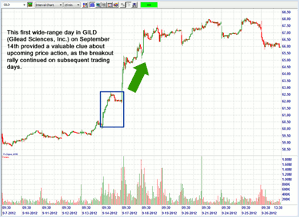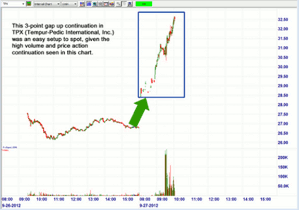In the second installment of a three-part series, professional trader, Ken Calhoun of TradeMastery.com and DaytradingUniversity.com, details the nuts-and-bolts of trading signals.
In the first article of this series, we looked at price action patterns using daily trading ranges and single trend breakout entry signals. This time, we’ll be taking a closer look at the “mechanics” of trading signals. As president of Day Trading University, our training has reached literally thousands of active traders in price action day and swing trading entry patterns using a very specific series of professional trading setups. We will review some of the most useful price action trading strategies in this series of articles.
The difference between using price action as a primary strategy, compared to other technical trading approaches, is that the volatility and price movement is considered the most important trading signal. While other indicators can still be used (most notably volume), it’s the overall “profile” of price action movements that takes precedence when making trading decisions.
Price Action Pattern #1: Using Moving Average Breakouts with Wide-Range Candles
On daily candlestick charts, it’s important to use the 50, 100 and 200 simple Moving Average (MA) lines, since those are widely used by institutional traders. One strong price action pattern to follow is a breakout above one of these lines, as seen in Figure 1 [Goldcorp, Inc. (GG)].
Not only did this price action break above the 41.5 level at the 200 MA crossover, but this was shortly followed by a wide-range candle that took the price from 43 to 45 in a single day. Oftentimes these setups can be observed, where an entry just above the MA breakout leads to a volatile price action move on a subsequent trading session, as seen here.
Initial entries can be made over the MA breakout signal, with secondary entries made following wide range candles, using stops of 1 to 1.5 points. Adding to winning positions by scaling in is an important component of price action based trading which will be covered in an upcoming article.
NEXT PAGE: Two Other Price Action Patterns
|pagebreak|Price Action Pattern #2: Swing Trading Entries Following Volatile Price Action Days
Looking for emerging new volatility in price action is a constant challenge for active traders. The key is to identify what has emerging new price action that’s most likely to attract additional movement in the traders’ favor after the trade is entered.
In Figure 2 [Gilead Sciences, Inc. (GILD)] the first clue that a volatile price action day would be likely to attract additional buyers came on September 14, as shown in the chart. Not only did price escape the prior trading consolidation range, but it also had a wider ATR (Average Trading Range) day than all of the prior five trading days. Looking for wider range days like this is a key to successful price action based trading.
Price Action Pattern #3: Gap Continuation High-Volume Trading
The author’s favorite intraday trading strategy can be seen in Figure 3 [Tempur-Pedic International, Inc. (TPX)], in which a minor gap continued for a high volume rally price action breakout. Looking for gaps that continue to new price highs can often provide some of the best day trading entries for active traders.
Entries are defined over the nearest .50-cent increment above the pre-market price action (in this case that would be 29.5 + .50 = 30.0 entry price, using no more than a .40 (forty cent) initial stop value. Adding to this type of entry on additional .50-cent increments for an intraday trading setup can help traders scale into winning trades, for additional leverage.
In our next article, we’ll look at new price-action based trading strategies for a variety of trading patterns. Identifying how to use price action to your advantage as an active trader can be a potentially successful technique that helps keep focused on your trading entries and exits.
Ken Calhoun is a trading professional who has traded millions of dollars of equities since the 1990s, and is the producer of multiple award-winning trading courses and video-based training systems for active traders. He is a UCLA alumnus and is the founder of TradeMastery.com andDaytradingUniversity.com, popular online educational sites for active traders.





















